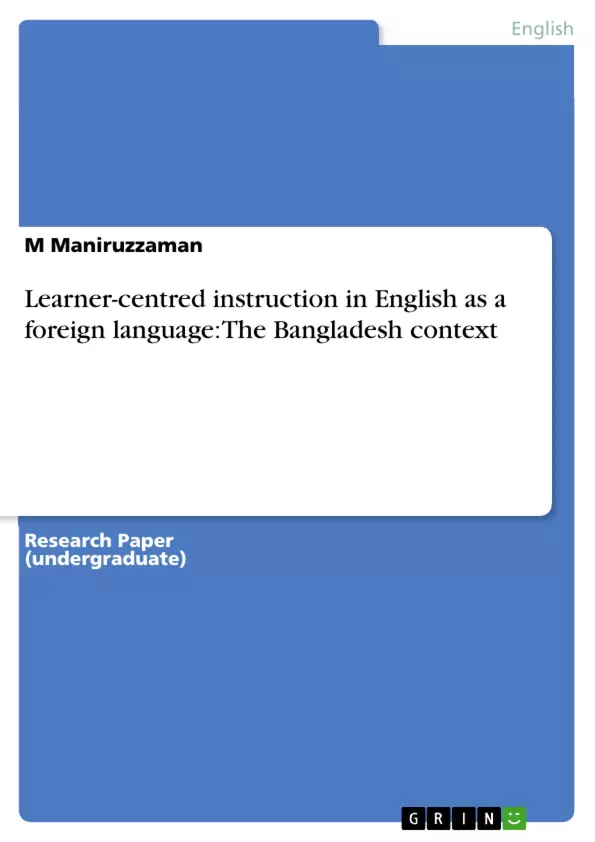Learner-centred instruction in a second/foreign language fosters learner autonomy, enhances metacognitive skills, and develops learners’ communicative competence, and is in consonance with the communicative language teaching approach to teaching English as a foreign language in Bangladesh. However, the current scenario of English education in the Bangladesh setting shaped by the age-old practice of the grammar-translation method and teacher-domination hardly exhibits learner-centredness. This paper then firstly tries to explicate learner autonomy, metacognition, and learner-centred second/foreign language classrooms, and secondly explores the Bangladesh context.
Inhaltsverzeichnis (Table of Contents)
- Abstract
- Learner autonomy
- Metacognition
- Learner-centered S/FL classrooms
Zielsetzung und Themenschwerpunkte (Objectives and Key Themes)
This paper aims to explain learner autonomy, metacognition, and learner-centered second/foreign language classrooms within the context of English language education in Bangladesh. It explores the challenges posed by traditional, teacher-dominated methods and contrasts them with the benefits of learner-centered approaches.
- Learner autonomy and its role in language acquisition
- Metacognition and its importance in effective learning
- Characteristics of learner-centered S/FL classrooms
- The challenges of implementing learner-centered instruction in Bangladesh
- Comparison of traditional and learner-centered approaches to English language teaching
Zusammenfassung der Kapitel (Chapter Summaries)
Learner autonomy: This section defines learner autonomy as learners taking responsibility for their own learning process, involving self-reflection and participation in decision-making regarding their communicative competence. It highlights the importance of learner autonomy in fostering enthusiasm, focus, and the development of self-confidence and independence in language learning. The author emphasizes the interconnectedness of learner autonomy with metacognition, specifically planning, decision-making, monitoring, and evaluation of the learning process. Several reasons are given for promoting learner autonomy, focusing on the increased efficiency and effectiveness of learning, improved motivation, and easier mastery of discourse roles for effective communication.
Metacognition: This section delves into the concept of metacognition, defining it as knowledge about one's cognitive processes and the ability to monitor and regulate them. It distinguishes between metacognitive knowledge (beliefs about oneself and the learning process) and metacognitive experiences (conscious cognitive and affective experiences during learning). The author explains how metacognitive knowledge informs learning strategies and how metacognitive experiences contribute to adjusting learning goals and expanding knowledge. The section emphasizes the importance of metacognitive training for fostering self-directed and autonomous learners.
Learner-centered S/FL classrooms: This section contrasts traditional, teacher-dominated S/FL classrooms with learner-centered ones. Traditional classrooms, often characterized by teacher-led lectures and drills, are criticized for their lack of interaction and learner autonomy. In contrast, learner-centered classrooms emphasize interaction between teacher and students and among students themselves, promoting negotiation of meaning and active participation. The author suggests that the interaction and negotiation of meaning are central to successful language learning, a feature absent in traditional, teacher-dominated classrooms.
Schlüsselwörter (Keywords)
Learner-centered instruction, learner autonomy, metacognition, communicative language teaching, Bangladesh, English as a foreign language, teacher-dominated classrooms, grammar-translation method.
FAQ: A Comprehensive Language Preview on Learner Autonomy, Metacognition, and Learner-Centered Classrooms in Bangladesh
What is the main focus of this paper?
This paper examines learner autonomy, metacognition, and learner-centered second/foreign language (S/FL) classrooms within the context of English language education in Bangladesh. It compares traditional, teacher-dominated methods with learner-centered approaches, highlighting the challenges and benefits of each.
What are the key themes explored in the paper?
The key themes include the role of learner autonomy in language acquisition, the importance of metacognition in effective learning, the characteristics of learner-centered S/FL classrooms, the challenges of implementing learner-centered instruction in Bangladesh, and a comparison of traditional and learner-centered approaches to English language teaching.
What is learner autonomy, and why is it important?
Learner autonomy is defined as learners taking responsibility for their own learning process, involving self-reflection and participation in decision-making. It fosters enthusiasm, focus, self-confidence, and independence. The paper emphasizes its interconnectedness with metacognition and its contribution to more efficient and effective learning, improved motivation, and easier mastery of discourse roles.
What is metacognition, and how does it relate to language learning?
Metacognition refers to knowledge about one's cognitive processes and the ability to monitor and regulate them. It encompasses metacognitive knowledge (beliefs about oneself and the learning process) and metacognitive experiences (conscious cognitive and affective experiences during learning). Metacognitive knowledge informs learning strategies, while metacognitive experiences help adjust learning goals and expand knowledge. Metacognitive training is crucial for fostering self-directed and autonomous learners.
How do traditional and learner-centered S/FL classrooms differ?
Traditional classrooms are often teacher-dominated, featuring lectures and drills, lacking interaction and learner autonomy. Learner-centered classrooms, in contrast, emphasize interaction between teacher and students and among students themselves, promoting negotiation of meaning and active participation. The paper argues that interaction and negotiation of meaning are crucial for successful language learning.
What are the challenges of implementing learner-centered instruction in Bangladesh?
While the paper doesn't explicitly list specific challenges, the comparison between traditional and learner-centered approaches implicitly highlights potential obstacles. These could include resistance to change from teachers accustomed to traditional methods, limited resources, large class sizes, and a lack of teacher training in learner-centered approaches.
What are the chapter summaries included in the preview?
The preview provides summaries for each of the main sections: Learner Autonomy, Metacognition, and Learner-Centered S/FL Classrooms. These summaries detail the key concepts and arguments presented in each section.
What are the keywords associated with this paper?
The keywords include: Learner-centered instruction, learner autonomy, metacognition, communicative language teaching, Bangladesh, English as a foreign language, teacher-dominated classrooms, and grammar-translation method.
- Quote paper
- Prof. Dr. M Maniruzzaman (Author), 2014, Learner-centred instruction in English as a foreign language: The Bangladesh context, Munich, GRIN Verlag, https://www.grin.com/document/285920



